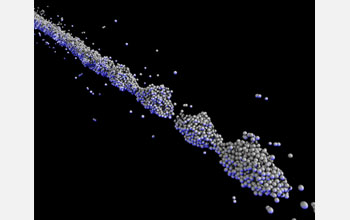All Images
News Release 09-129
Stream of Sand Behaves Like Water
Research opens up new experimental territory
This material is available primarily for archival purposes. Telephone numbers or other contact information may be out of date; please see current contact information at media contacts.

In a first-time accomplishment, physicists from the Materials Research Science and Engineering Center at the University of Chicago used high-speed photography to measure minute levels of surface tension and detect droplet formation in flows of dry granular materials. The finding could be important to industries that use "fluidized" dry particles for oil refining, plastics manufacturing, pharmaceutical production and other mechanized processes.
Credit: Helge F. Gruetjen*, John R. Royer, Scott R. Waitukaitis, and Heinrich M. Jaeger, The University of Chicago
Download the high-resolution JPG version of the image. (624 KB)
Use your mouse to right-click (Mac users may need to Ctrl-click) the link above and choose the option that will save the file or target to your computer.
In this high speed video of a freely falling granular stream, viewers see a specially designed camera apparatus move alongside an initial acceleration period and track the formation of grain clusters, similar to the formation of droplets for a water stream falling from a faucet.
Credit: John Royer and Heinrich Jaeger, The University of Chicago
